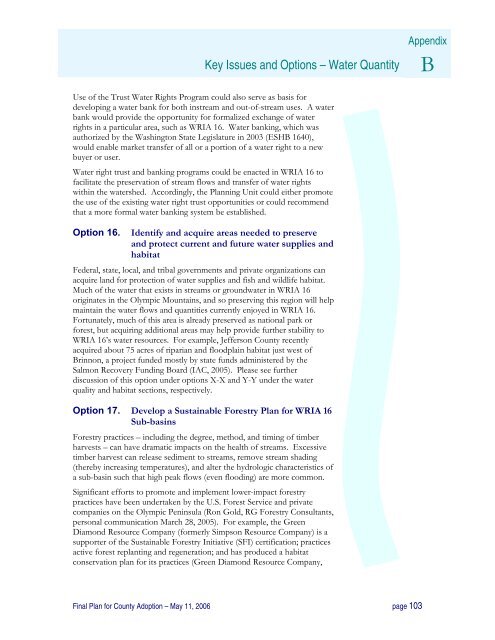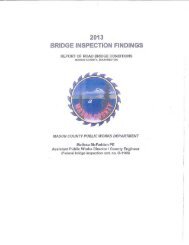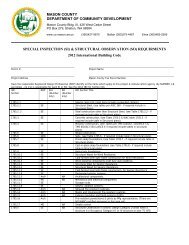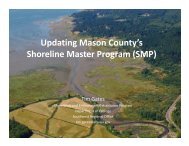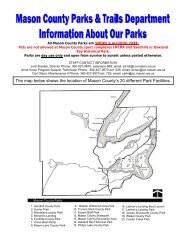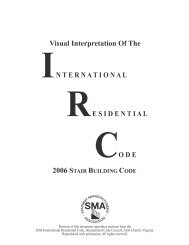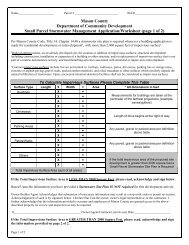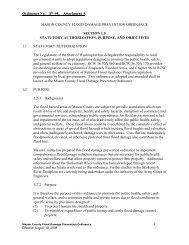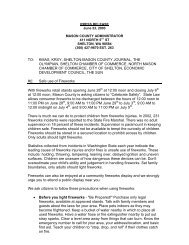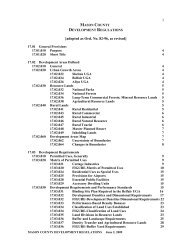Watershed Management Plan - Mason County
Watershed Management Plan - Mason County
Watershed Management Plan - Mason County
You also want an ePaper? Increase the reach of your titles
YUMPU automatically turns print PDFs into web optimized ePapers that Google loves.
Key Issues and Options – Water Quantity<br />
Appendix<br />
B<br />
Use of the Trust Water Rights Program could also serve as basis for<br />
developing a water bank for both instream and out-of-stream uses. A water<br />
bank would provide the opportunity for formalized exchange of water<br />
rights in a particular area, such as WRIA 16. Water banking, which was<br />
authorized by the Washington State Legislature in 2003 (ESHB 1640),<br />
would enable market transfer of all or a portion of a water right to a new<br />
buyer or user.<br />
Water right trust and banking programs could be enacted in WRIA 16 to<br />
facilitate the preservation of stream flows and transfer of water rights<br />
within the watershed. Accordingly, the <strong>Plan</strong>ning Unit could either promote<br />
the use of the existing water right trust opportunities or could recommend<br />
that a more formal water banking system be established.<br />
Option 16.<br />
Identify and acquire areas needed to preserve<br />
and protect current and future water supplies and<br />
habitat<br />
Federal, state, local, and tribal governments and private organizations can<br />
acquire land for protection of water supplies and fish and wildlife habitat.<br />
Much of the water that exists in streams or groundwater in WRIA 16<br />
originates in the Olympic Mountains, and so preserving this region will help<br />
maintain the water flows and quantities currently enjoyed in WRIA 16.<br />
Fortunately, much of this area is already preserved as national park or<br />
forest, but acquiring additional areas may help provide further stability to<br />
WRIA 16’s water resources. For example, Jefferson <strong>County</strong> recently<br />
acquired about 75 acres of riparian and floodplain habitat just west of<br />
Brinnon, a project funded mostly by state funds administered by the<br />
Salmon Recovery Funding Board (IAC, 2005). Please see further<br />
discussion of this option under options X-X and Y-Y under the water<br />
quality and habitat sections, respectively.<br />
Option 17. Develop a Sustainable Forestry <strong>Plan</strong> for WRIA 16<br />
Sub-basins<br />
Forestry practices – including the degree, method, and timing of timber<br />
harvests – can have dramatic impacts on the health of streams. Excessive<br />
timber harvest can release sediment to streams, remove stream shading<br />
(thereby increasing temperatures), and alter the hydrologic characteristics of<br />
a sub-basin such that high peak flows (even flooding) are more common.<br />
Significant efforts to promote and implement lower-impact forestry<br />
practices have been undertaken by the U.S. Forest Service and private<br />
companies on the Olympic Peninsula (Ron Gold, RG Forestry Consultants,<br />
personal communication March 28, 2005). For example, the Green<br />
Diamond Resource Company (formerly Simpson Resource Company) is a<br />
supporter of the Sustainable Forestry Initiative (SFI) certification; practices<br />
active forest replanting and regeneration; and has produced a habitat<br />
conservation plan for its practices (Green Diamond Resource Company,<br />
Final <strong>Plan</strong> for <strong>County</strong> Adoption – May 11, 2006 page 103


